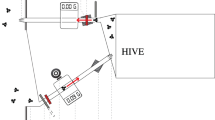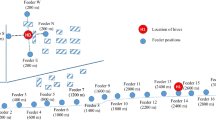Abstract
Nectar foraging in honey bees is regulated by several communication signals that are performed mainly by foragers. One of these signals is the tremble dance, which is consistently performed by foragers from a rich food source which, upon return to the hive, experience a long delay before unloading their nectar to a nectar receiver. Although tremble dancing has been studied extensively using artificial nectar sources, its occurrence and context in a more natural setting remain unknown. Therefore, this study tests the sufficiency of the current explanations for tremble dancing by free-foraging honey bees. The main finding is that only about half of the observations of tremble dancing, referred to as delay-type tremble dancing, are a result of difficulty in finding a nectar receiver. In the remaining observations, tremble dancing was initiated immediately upon entering the hive, referred to as non-delay-type tremble dancing. Non-delay tremble dancing was associated with first foraging successes, both in a forager's career and in a single day. More than 75% of tremble dancing was associated with good foraging conditions, as indicated by the dancer continuing to forage after dancing. However, at least some of the other cases were associated with deteriorated foraging conditions, such as the end of the day, after which foraging was discontinued. No common context could be identified that explains all cases of tremble dancing or the subset of non-delay-type tremble dancing. This study shows that the current explanations for the cause of the tremble dance are insufficient to explain all tremble dancing in honey bees that forage at natural food sources.



Similar content being viewed by others
References
Adam B (1987) Beekeeping at Buckfast Abbey. Northern Bee Books, Hebden Bridge
Anderson C, Ratnieks FLW (1999) Worker allocation in insect societies: coordination of nectar foragers and nectar receivers in honey bee (Apis mellifera) colonies. Behav Ecol Sociobiol 46:73–81
Frisch K von (1923) Über die "Sprache" der Bienen eine tierpsychologische Untersuchung. Zool Jahrb Abt Allg Zool Physiol Tiere 40:1–186
Frisch K von (1946) Die Tänze der Bienen. Öst Zool Z 1:1–48
Frisch K von (1967) The dance language and orientation of bees. Harvard University Press, Cambridge, Mass
Kirchner WH (1993) Vibrational signals in the tremble dance of the honeybee, Apis mellifera. Behav Ecol Sociobiol 33:169–172
Kirchner WH, Lindauer M (1994) The causes of the tremble dance of the honeybee, Apis mellifera. Behav Ecol Sociobiol 35:303–308
Lindauer M (1948) Über die einwirkung von Duft- und Geschmackstoffen sowie anderer Faktoren auf die Tänze der Bienen. Z Vgl Physiol 31:348–412
Nieh JC (1993) The stop signal of honey bees: reconsidering its message. Behav Ecol Sociobiol 33:51–56
Schick W (1953) Über die Wirkung der Giftstoffen auf die Tänze der Bienen. Z Vgl Physiol 35:105–128
Schneider F (1949) Über die Vergiftung der Bienen mit Dinitrokresol. Mitt Schweiz Entomol Ges 22:293–308
Seeley TD (1992) The tremble dance of the honey bee: message and meanings. Behav Ecol Sociobiol 31:375–383
Seeley TD (1995) The wisdom of the hive. Harvard University Press, Cambridge
Seeley TD, Kühnholz S, Weidenmüller A (1996) The honey bee's tremble dance stimulates additional bees to function as nectar receivers. Behav Ecol Sociobiol 39:419–427
Siegel S, Castellan NJ Jr (1988) Nonparametric statistics for the behavioral sciences. McGraw-Hill, New York
Sokal RR, Rohlf FJ (1981) Biometry, 2nd edn. Freeman, New York
Visscher PK, Seeley TD (1982) Foraging strategy of honeybee colonies in a temperate deciduous forest. Ecology 62:1790–1801
Vries H de, Biesmeijer JC (2002) Self-organization in collective honeybee foraging: emergence of symmetry breaking, cross inhibition and equal harvest-rate distribution. Behav Ecol Sociobiol 51:557–569
Acknowledgements
Thanks go to Tom Seeley for being a generous host and an invaluable source of advice, and to Peter Matisson, Chris Hood, Ethan Ebner, Judith Slaa, and Mark Laidre for allowing me to stretch my legs and enjoy the sunshine for some hours each day. Tom Seeley, David Tarpy, and Judith Slaa made valuable suggestions that improved the manuscript. N.W.O., the Netherlands foundation for scientific research, supported this research financially through a fellowship in their TALENT-program. The study complies with the current laws of the United States of America.
Author information
Authors and Affiliations
Corresponding author
Additional information
Communicated by M. Giurfa
Rights and permissions
About this article
Cite this article
Biesmeijer, J.C. The occurrence and context of tremble dancing in free-foraging honey bees (Apis mellifera). Behav Ecol Sociobiol 53, 411–416 (2003). https://doi.org/10.1007/s00265-003-0597-0
Received:
Revised:
Accepted:
Published:
Issue Date:
DOI: https://doi.org/10.1007/s00265-003-0597-0




